Atlantic Monthly Contributors's Blog, page 407
June 23, 2015
A Motel-Sized Victory for Privacy at the Supreme Court
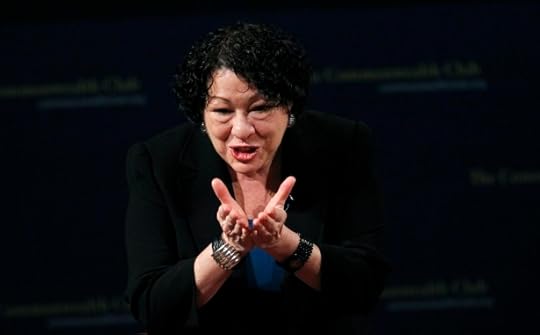
In Los Angeles, where Ben Braddock registered as Mr. Gladstone before starting his affair with Mrs. Robinson, hotel and motel operators are required by law to be nosy. They may not say, “Welcome to my inn, where your business is your own,” for they must record each guest’s name and address; the number of people in her party; her date and time of arrival; her planned date of departure; her room number; the rate she is paying; her method of payment; her ID number if she failed to reserve in advance, paid cash, or rented for 12 hours or less; and information on her vehicle (forcing her to return to the parking lot to take down the plate number).
This registration information must be stored for 90 days. Front desk employees must be trained to record it per municipal regulations. And they must turn it over to authorities when given a lawful subpoena or search warrant. But what if an LAPD officer comes to the lobby, sans warrant, and demands to inspect these records?
The city has sought to force innkeepers to comply with any such request from any police officer. A law declared any failure to make guest records available for police inspection a misdemeanor punishable by 6 months in jail and a $1,000 fine. It wouldn’t matter if a rookie LAPD officer arrived on his own initiative and demanded the registration card of a Black Lives Matter organizer in town for a conference or an actress whose home address he hoped to pilfer. The innkeeper could not refuse. The nosy cop could arrest the innkeeper immediately if he dared try.
On Monday, the Supreme Court declared that law unconstitutional.
The majority opinion was written by Justice Sonia Sotomayor, the high court’s foremost champion of safeguarding privacy rights against aggressive searches and seizures. The 5-to-4 ruling, embraced by the court’s liberal wing, struck down the law because it penalizes people for failing to give up records without affording any opportunity to challenge the lawfulness or reasonableness of the request.
With rare exceptions, for an administrative search to be constitutional, the subject “must be afforded an opportunity to obtain precompliance review before a neutral decision maker,” Sotomayor wrote. “We see no reason why this minimal requirement is inapplicable here.” Although the Court has never specified the form such a review must take, Los Angeles did not even attempt to argue that its law affords hotel operators any opportunity for a challenge, meaning that a hotel owner who refuses access to his or her registry “can be arrested on the spot.”
The law is therefore “facially invalid,” she wrote.
Sotomayor went on to explain why she believes that upholding the law would have been dangerous.
“The ordinance creates an intolerable risk that searches authorized by it will exceed statutory limits, or be used as a pretext to harass hotel operators and their guests,” she explains. “Even if a hotel has been searched 10 times a day, every day, for three months, without any violation being found, the operator can only refuse to comply with an officer’s demand to turn over the registry at his or her own peril.” Now, misbehavior by L.A. or municipalities with similar hotel regulations can be checked before police can coerce innkeepers into granting abusive requests. And police will continue to get cooperation most times from most inns, at least if they treat innkeepers with respect and don’t abuse their authority.
As for inns rife with criminals and complicit innkeepers, police can send an undercover cop with $50 in bribe money to ascertain if the register requirement is easily avoided; or they can go through minimal administrative burdens to see the whole registry, though I don’t see why known criminals wouldn’t use fake names and IDs.
* * *
Justice Antonin Scalia was unmoved by the majority opinion. Writing in a dissent joined by Justices Roberts and Thomas, he declared that inns belong to a special class of heavily regulated industries for which long precedent holds that “when an entrepreneur embarks upon such a business, he has voluntarily chosen to subject himself to a full arsenal of governmental regulation.” At the time of the Founding, “searches—indeed, warrantless searches—of inns and similar places of public accommodation were commonplace,” the conservative jurist observed. “For example, although Massachusetts was perhaps the State most protective against government searches, ‘the state code of 1788 still allowed tithingmen to search public houses of entertainment on every Sabbath without any sort of warrant.’”
Scalia argues that L.A.’s law “furthers a substantial governmental interest” by deterring criminal activity like drug dealing, prostitution, and human trafficking, and reasons that warrantless searches are “necessary to achieving that interest,” because they provide “a necessary incentive for motels to maintain their registers thoroughly and accurately: They never know when law enforcement might drop by to inspect.” Without the requirement, he adds, innkeepers who conspire with drug dealers or procurers of prostitutes “may demand precompliance judicial review simply as a pretext to buy time for making fraudulent entries in their guest registers.”*
Put more succinctly, Scalia believes that because some motel guests commit serious crimes, and because some motel owners conspire to hide that fact from police, it is reasonable to impose warrantless searches on all hotel and motel operators, without any way to preemptively challenge even the most egregious requests, and even absent suspicion that any crime is occurring on the premises being scrutinized. “Because I believe that the limited warrantless searches authorized... are reasonable under the circumstances,” he wrote, “I respectfully dissent.”
* * *
As I noted last year when the Supreme Court first agreed to hear Los Angeles v. Patel, it’s worth stepping back to think through the logic embraced by Los Angeles, the LAPD, a district court, a Ninth Circuit dissent, and now, four dissenting Supreme Court justices. All seem comfortable with something that wasn’t addressed directly in this case: the notion that hotel and motel guests have no right to privacy in information that they voluntarily turn over to third parties, per Smith v. Maryland.
The third-party information precedent is problematic on its own.
But it is devastating to privacy when paired with laws that compel businesses to collect detailed information on customers and to turn it over to police without warrants, destroying the ability to enter voluntary transactions that include discretion.
The practical effect of this two-step is that Americans cannot travel without waiving privacy rights to personal details as intimate as where they go, the times they arrive and leave, who stays with them in their rooms, and how many beds are inside those rooms. If the state is permitted to seize all that information without probable cause or a warrant, the Fourth Amendment is devalued, especially if the same logic is extended to other businesses: Most people can't function in modern society without revealing virtually every aspect of their lives to some “third party” or other. By compelling those businesses to track us, Big Brother gains many minions.
Even staying within the narrow bounds of inn records, it is easy to imagine a day very soon when paper registration is totally abandoned and all registries are held electronically, whether as a matter of convenience or because regulators compel it.
Permitting electronic access to police would be trivially easy. (In fact, the brief submitted by Los Angeles raises a hypothetical in which “the City requires any hotel that uses an electronic register to enter the information into a City database in real time over the Internet,” a scenario that it regards as obviously lawful.)
At that point, when L.A.’s convention center hosts the national conference of the National Rifle Association or the American Civil Liberties Union or the Green Party, should local cops have warrantless e-access to the names of all hotel guests? Scalia’s jurisprudence would give L.A.’s hotels no way to preempt such informational hoovering, perhaps because he’s so focused on the long history of inns keeping records that he doesn’t appreciate what the future holds for the practice: an easily compilable record of all travelers as they move about the country.
And one wonders what Arizona Sheriff Joe Arpaio will do if and when he can check all hotel registries from his computer. I expect guests with Spanish surnames will be first to find out.
Now let’s return to the present.
A brief put forth by Los Angeles in this case argued that a hotel operator’s “individual privacy concerns pale in comparison to the City’s legitimate interest in deterring prostitutes, drug dealers, and other serious criminals from committing crimes in hotels. Hotels have only a limited privacy interest in their required registers.” If you suddenly found yourself owning and operating a motel in Los Angeles, would you feel a limited privacy interest or a strong privacy interest in the fact that a prominent LAPD whistleblower, the wife of an LAPD officer put on administrative leave for domestic violence, or a group of anti-police activists were staying at your hotel, where you hope for future police protection from criminals?
Going forward, a libertarian approach to Fourth Amendment law would offer much better protection. “When a search or seizure occurs, its effect on privacy is one consideration in determining whether or not it was reasonable,” the Cato Institute declared in its amicus brief on this case. “Privacy invasion is not, however, the sine qua non of unreasonable searches and seizures. Instead of asking whether Los Angeles hoteliers have an ‘expectation of privacy’ in their business records, this Court should examine whether their right ‘to be secure in their persons, houses, papers, and effects, against unreasonable searches and seizures’ is infringed by a statute that requires them to create business records and make them available for search on their premises by ‘any officer of the Los Angeles Police Department,’ for any reason or no reason, and without a warrant.”
After Monday’s ruling, Jim Harper, a co-author of that brief, speculated that had the Court considered the totality of L.A.’s “warrantless search scheme,” it would’ve assessed “whether it is reasonable in our constitutional system for private businesses to be dragooned into wholesale, comprehensive surveillance on behalf of the government,” a scope that “might have brought the Court’s conservatives off the sidelines and into defending the degree of privacy against government that existed when the Fourth Amendment was adopted. Surely, the government couldn’t have conscripted businesses into mass surveillance of the public at the time of the framing.”
But for years, self-described conservatives have chipped away at the Fourth Amendment by privileging the convenience of police over the privacy of innocents. In so doing, they’ve helped America’s cops to significantly reduce drug trafficking and prostitution in America––wait, no, it’s actually as easy as ever to buy drugs or sex, and neither would be done in crime-ridden motels if the associated vices were brought under sane regulators rather than black market dons.
Despite the fact that the ostensibly compelling reasons for eroding the Fourth Amendment have mostly failed to bring about the desired ends, I fear that the Supreme Court’s conservatives will continue embracing positions that weaken it, even as the government’s ability to collect, store, and analyze information about innocents exceeds anything that the Framers could have imagined or would have permitted. Absent a significant change in jurisprudence, an increasingly comprehensive surveillance state is all but inevitable in the U.S. And Sotomayor seems more inclined to protect privacy than any of the court’s Republican appointees.








June 22, 2015
What This Cruel War Was Over
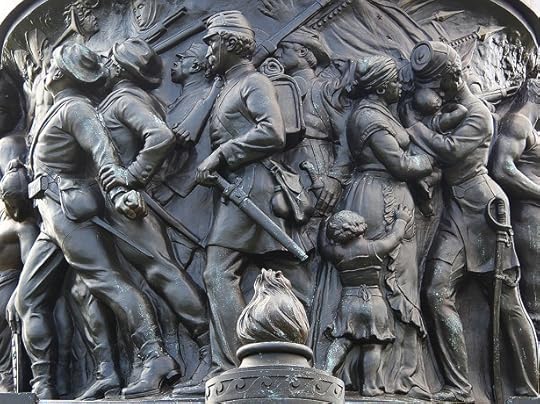
This afternoon, in announcing her support for removing the Confederate flag from the capitol grounds, South Carolina Governor Nikki Haley asserted that killer Dylann Roof had “a sick and twisted view of the flag” which did not reflect “the people in our state who respect and in many ways revere it.” If the governor meant that very few of the flag’s supporters believe in mass murder, she is surely right. But on the question of whose view of the Confederate Flag is more twisted, she is almost certainly wrong.
Roof’s belief that black life had no purpose beyond subjugation is “sick and twisted” in the exact same manner as the beliefs of those who created the Confederate flag were “sick and twisted.” The Confederate flag is directly tied to the Confederate cause, and the Confederate cause was white supremacy. This claim is not the result of revisionism. It does not require reading between the lines. It is the plain meaning of the words of those who bore the Confederate flag across history. These words must never be forgotten. Over the next few months the word “heritage” will be repeatedly invoked. It would be derelict to not examine the exact contents of that heritage.
This examination should begin in South Carolina, the site of our present and past catastrophe. South Carolina was the first state to secede, two months after the election of Abraham Lincoln. It was in South Carolina that the Civil War began, when the Confederacy fired on Fort Sumter. The state’s casus belli was neither vague nor hard to comprehend:
...A geographical line has been drawn across the Union, and all the States north of that line have united in the election of a man to the high office of President of the United States, whose opinions and purposes are hostile to slavery. He is to be entrusted with the administration of the common Government, because he has declared that that “Government cannot endure permanently half slave, half free,” and that the public mind must rest in the belief that slavery is in the course of ultimate extinction. This sectional combination for the submersion of the Constitution, has been aided in some of the States by elevating to citizenship, persons who, by the supreme law of the land, are incapable of becoming citizens; and their votes have been used to inaugurate a new policy, hostile to the South, and destructive of its beliefs and safety.
In citing slavery, South Carolina was less an outlier than a leader, setting the tone for other states, including Mississippi:
Our position is thoroughly identified with the institution of slavery—the greatest material interest of the world. Its labor supplies the product which constitutes by far the largest and most important portions of commerce of the earth. These products are peculiar to the climate verging on the tropical regions, and by an imperious law of nature, none but the black race can bear exposure to the tropical sun. These products have become necessities of the world, and a blow at slavery is a blow at commerce and civilization. That blow has been long aimed at the institution, and was at the point of reaching its consummation. There was no choice left us but submission to the mandates of abolition, or a dissolution of the Union, whose principles had been subverted to work out our ruin…
As a separate republic, Louisiana remembers too well the whisperings of European diplomacy for the abolition of slavery in the times of annexation not to be apprehensive of bolder demonstrations from the same quarter and the North in this country. The people of the slave holding States are bound together by the same necessity and determination to preserve African slavery.
Upon the principles then announced by Mr. Lincoln and his leading friends, we are bound to expect his administration to be conducted. Hence it is, that in high places, among the Republican party, the election of Mr. Lincoln is hailed, not simply as it change of Administration, but as the inauguration of new principles, and a new theory of Government, and even as the downfall of slavery. Therefore it is that the election of Mr. Lincoln cannot be regarded otherwise than a solemn declaration, on the part of a great majority of the Northern people, of hostility to the South, her property and her institutions—nothing less than an open declaration of war—for the triumph of this new theory of Government destroys the property of the South, lays waste her fields, and inaugurates all the horrors of a San Domingo servile insurrection, consigning her citizens to assassinations, and. her wives and daughters to pollution and violation, to gratify the lust of half-civilized Africans.
...in this free government all white men are and of right ought to be entitled to equal civil and political rights; that the servitude of the African race, as existing in these States, is mutually beneficial to both bond and free, and is abundantly authorized and justified by the experience of mankind, and the revealed will of the Almighty Creator, as recognized by all Christian nations; while the destruction of the existing relations between the two races, as advocated by our sectional enemies, would bring inevitable calamities upon both and desolation upon the fifteen slave-holding states....
None of this was new. In 1858, the eventual president of the Confederacy Jefferson Davis threatened secession should a Republican be elected to the presidency:
I say to you here as I have said to the Democracy of New York, if it should ever come to pass that the Constitution shall be perverted to the destruction of our rights so that we shall have the mere right as a feeble minority unprotected by the barrier of the Constitution to give an ineffectual negative vote in the Halls of Congress, we shall then bear to the federal government the relation our colonial fathers did to the British crown, and if we are worthy of our lineage we will in that event redeem our rights even if it be through the process of revolution.
It is difficult for modern Americans to understand such militant commitment to the bondage of others. But at $3.5 billion, the four million enslaved African Americans in the South represented the country’s greatest financial asset. And the dollar amount does not hint at the force of enslavement as a social institution. By the onset of the Civil War, Southern slaveholders believed that African slavery was one of the great organizing institutions in world history, superior to the “free society” of the North.
From an 1856 issue of Alabama’s Muscogee Herald:
Free Society! we sicken at the name. What is it but a conglomeration of greasy mechanics, filthy operatives, small-fisted farmers, and moon-struck theorists? All the Northern men and especially the New England States are devoid of society fitted for well-bred gentlemen. The prevailing class one meet with is that of mechanics struggling to be genteel, and small farmers who do their own drudgery, and yet are hardly fit for association with a Southern gentleman's body servant. This is your free society which Northern hordes are trying to extend into Kansas.
The last sentence refers to the conflict over slavery between free-soilers and slave-holders. The conflict was not merely about the right to hold another human in bondage, but how that right created the foundation for white equality.
You too know, that among us, white men have an equality resulting from a presence of a lower caste, which cannot exist where white men fill the position here occupied by the servile race. The mechanic who comes among us, employing the less intellectual labor of the African, takes the position which only a master-workman occupies where all the mechanics are white, and therefore it is that our mechanics hold their position of absolute equality among us.
Black slavery as the basis of white equality was a frequent theme for slaveholders. In his famous “Cotton Is King” speech, James Henry Hammond compared the alleged wage slavery of the North with black slavery—and white equality—in the South:
The difference between us is, that our slaves are hired for life and well compensated; there is no starvation, no begging, no want of employment among our people, and not too much employment either. Yours are hired by the day, not cared for, and scantily compensated, which may be proved in the most painful manner, at any hour in any street of your large towns. Why, you meet more beggars in one day, in any single street of the city of New York, than you would meet in a lifetime in the whole South.
We do not think that whites should be slaves either by law or necessity. Our slaves are black, of another and inferior race. The status in which we have placed them is an elevation. They are elevated from the condition in which God first created them, by being made our slaves. None of that race on the whole face of the globe can be compared with the slaves of the South. They are happy, content, unaspiring, and utterly incapable, from intellectual weakness, ever to give us any trouble by their aspirations. Yours are white, of your own race; you are brothers of one blood. They are your equals in natural endowment of intellect, and they feel galled by their degradation.
On the eve of secession, Georgia Governor Joseph E. Brown concurred:
Among us the poor white laborer is respected as an equal. His family is treated with kindness, consideration and respect. He does not belong to the menial class. The negro is in no sense of the term his equal. He feels and knows this. He belongs to the only true aristocracy, the race of white men. He black no masters boots, and bows the knee to no one save God alone. He receives higher wages for his labor than does the laborer of any other portion of the world, and he raises up his children with the knowledge, that they belong to no inferior cast, but that the highest members of the society in which he lives, will, if their conduct is good, respect and treat them as equals.
Thus in the minds of these Southern nationalists, the destruction of slavery would not merely mean the loss of property but the destruction of white equality, and thus of the peculiar Southern way of life:
If the policy of the Republicans is carried out, according to the programme indicated by the leaders of the party, and the South submits, degradation and ruin must overwhelm alike all classes of citizens in the Southern States. The slave-holder and non-slave-holder must ultimately share the same fate—all be degraded to a position of equality with free negroes, stand side by side with them at the polls, and fraternize in all the social relations of life; or else there will be an eternal war of races, desolating the land with blood, and utterly wasting and destroying all the resources of the country.
Slaveholders were not modest about the perceived virtues of their way of life. In the years leading up to the Civil War, calls for expansion into the tropics reached a fever pitch, and slaveholders marveled at the possibility of spreading a new empire into central America:
Looking into the possibilities of the future, regarding the magnificent country of tropical America, which lies in the path of our destiny on this continent, we may see an empire as powerful and gorgeous as ever was pictured in our dreams of history. What is that empire? It is an empire founded on military ideas; representing the noble peculiarities of Southern civilization; including within its limits the isthmuses of America and the regenerated West Indies; having control of the two dominant staples of the world's commerce—cotton and sugar; possessing the highways of the world's commerce; surpassing all empires of the age in the strength of its geographical position; and, in short, combining elements of strength, prosperity, and glory, such as never before in the modern ages have been placed within the reach of a single government. What a splendid vision of empire!
How sublime in its associations! How noble and inspiriting the idea, that upon the strange theatre of tropical America, once, if we may believe the dimmer facts of history, crowned with magnificent empires and flashing cities and great temples, now covered with mute ruins, and trampled over by half-savages, the destiny of Southern civilization is to be consummated in a glory brighter even than that of old, the glory of an empire, controlling the commerce of the world, impregnable in its position, and representing in its internal structure the most harmonious of all the systems of modern civilization.
Edward Pollard, the journalist who wrote that book, titled it Black Diamonds Gathered In The Darkey Homes Of The South. Perhaps even this is too subtle. In 1858, Mississippi Senator Albert Gallatin Brown was clearer:
I want Cuba, and I know that sooner or later we must have it. If the worm-eaten throne of Spain is willing to give it for a fair equivalent, well—if not, we must take it. I want Tamaulipas, Potosi, and one or two other Mexican Stats; and I want them all for the same reason—for the planting and spreading of slavery.
And a footing in Central America will powerfully aid us in acquiring those other states. It will render them less valuable to the other powers of the earth, and thereby diminish competition with us. Yes, I want these countries for the spread of slavery. I would spread the blessings of slavery, like the religion of our Divine Master, to the uttermost ends of the earth, and rebellious and wicked as the Yankees have been, I would even extend it to them.
I would not force it upon them, as I would not force religion upon them, but I would preach it to them, as I would preach the gospel. They are a stiff-necked and rebellious race, and I have little hope that they will receive the blessing, and I would therefore prepare for its spread to other more favored lands.
Thus in 1861, when the Civil War began, the Union did not face a peaceful Southern society wanting to be left alone. It faced an an aggressive power, a Genosha, an entire society based on the bondage of a third of its residents, with dreams of expanding its fields of the bondage further South. It faced the dream of a vast American empire of slavery. In January of 1861, three months before the Civil War commenced, Florida secessionists articulated the position directly:
At the South, and with our People of course, slavery is the element of all value, and a destruction of that destroys all that is property. This party, now soon to take possession of the powers of the Government, is sectional, irresponsible to us, and driven on by an infuriated fanatical madness that defies all opposition, must inevitably destroy every vestige or right growing out of property in slaves.
Gentlemen, the State of Florida is now a member of the Union under the power of the Government, so to go into the hands of this party.
As we stand our doom is decreed.
Not yet. As the Late Unpleasantness stretched from the predicted months into years, the very reason for the Confederacy’s existence came to threaten its diplomatic efforts. Fighting for slavery presented problems abroad, and so Confederate diplomats came up with the notion of emphasizing “states rights” over “slavery”—the first manifestation of what would later become a plank in the foundation of Lost Cause mythology.
The first people to question that mythology were themselves Confederates, distraught to find their motives downplayed or treated as embarassments. A Richmond-based newspaper offered the following:
‘The people of the South,’ says a contemporary, ‘are not fighting for slavery but for independence.’ Let us look into this matter. It is an easy task, we think, to show up this new-fangled heresy — a heresy calculated to do us no good, for it cannot deceive foreign statesmen nor peoples, nor mislead any one here nor in Yankeeland. . . Our doctrine is this: WE ARE FIGHTING FOR INDEPENDENCE THAT OUR GREAT AND NECESSARY DOMESTIC INSTITUTION OF SLAVERY SHALL BE PRESERVED, and for the preservation of other institutions of which slavery is the groundwork.
Even after the war, as the Lost Cause rose, many veterans remained clear about why they had rallied to the Confederate flag. “I’ve never heard of any other cause than slavery,” wrote Confederate commander John S. Mosby. The progeny of the Confederacy repeatedly invoked slavery as the war’s cause.
Here, for example, is Mississippi Senator John Sharp Williams in 1904:
Local self-government temporarily destroyed may be recovered and ultimately retained. The other thing for which we fought is so complex in its composition, so delicate in its breath, so incomparable in its symmetry, that, being once destroyed, it is forever destroyed. This other thing for which we fought was the supremacy of the white man’s civilization in the country which he proudly claimed his own; “in the land which the Lord his God had given him;” founded upon the white man’s code of ethics, in sympathy with the white man’s traditions and ideals.
The Confederate Veteran—the official publication of the United Confederate Veterans—in 1906:
The Confederate Veteran again in 1911:The kindliest relation that ever existed between the two races in this country, or that ever will, was the ante-bellum relation of master and slave—a relation of confidence and responsibility on the part of the master and of dependence and fidelity on the part of the slave.
The African, coming from a barbarous state and from a tropical climate, could not meet the demands for skilled labor in the factories of the Northern States; neither could he endure the severe cold of the Northern winter. For these reasons it was both merciful and “business” to sell him to the Southern planter, where the climate was more favorable and skilled labor not so important. In the South the climate, civilization, and other influences ameliorated the African’s condition, and that of almost the entire race of slaves, which numbered into the millions before their emancipation. It should be noted that their evangelization was the most fruitful missionary work of any modern Christian endeavor. The thoughtful and considerate negro of to-day realizes his indebtedness to the institution of African slavery for advantages which he would not have received had he remained in his semi-barbarism waiting in his native jungles for the delayed missionary.
And in 1917, the Confederate Veteran singled out one man for particular praise:
Great and trying times always produce great leaders, and one was at hand—Nathan Bedford Forrest. His plan, the only course left open. The organization of a secret government. A terrible government; a government that would govern in spite of black majorities and Federal bayonets. This secret government was organized in every community in the South, and this government is known in history as the Klu Klux Clan...
Here in all ages to come the Southern romancer and poet can find the inspiration for fiction and song. No nobler or grander spirits ever assembled on this earth than gathered in these clans. No human hearts were ever moved with nobler impulses or higher aims and purposes….Order was restored, property safe; because the negro feared the Klu Klux Clan more than he feared the devil. Even the Federal bayonets could not give him confidence in the black government which had been established for him, and the negro voluntarily surrendered to the Klu Klux Clan, and the very moment he did, the “Invisible Army” vanished in a night. Its purpose had been fulfilled.
Bedford Forrest should always be held in reverence by every son and daughter of the South as long as memory holds dear the noble deeds and service of men for the good of others on, this earth. What mind is base enough to think of what might have happened but for Bedford Forrest and his “Invisible” but victorious army.
In praising the Klan’s terrorism, Confederate veterans and their descendants displayed a remarkable consistency. White domination was the point. Slavery failed. Domination prevailed nonetheless. This was the basic argument of Florida Democratic Senator Duncan Fletcher. “The Cause Was Not Entirely Lost,” he argued in a 1931 speech before the United Daughters of the Confederacy:
The South fought to preserve race integrity. Did we lose that? We fought to maintain free white dominion. Did we lose that? The States are in control of the people. Local self-government, democratic government, obtains. That was not lost. The rights of the sovereign States, under the Constitution, are recognized. We did not lose that. I submit that what is called “The Lost Cause” was not so much “lost” as is sometimes supposed.
Indeed it was not. For a century after the Civil War, White Supremacy ruled the South. Toward the end of that century, as activists began to effectively challenge white supremacy, its upholders reached for a familiar symbol.
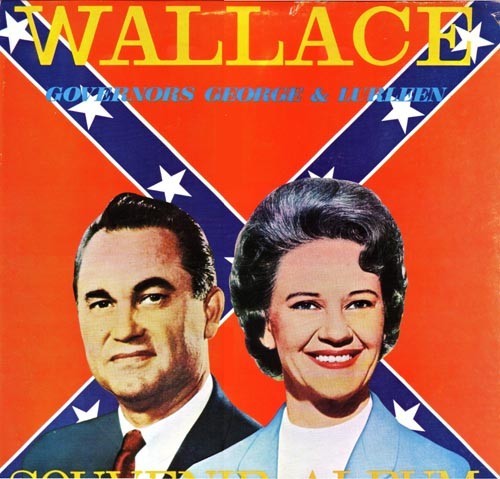
Invocations of the flag were supported by invocations of the Confederacy itself. But by then, neo-Confederates had begun walking back their overt defenses of slavery. United Daughters of the Confederacy Magazine claimed that...
Jefferson Davis, Robert E. Lee, Thomas Jonathan Stonewall Jackson, Nathan Bedford Forrest, Raphael Semmes and the 600,000 soldiers and sailors of the Confederacy did not fight for a “Lost Cause.” They fought to repel invasion, and in defense of their Constitutional liberties bequeathed them by their forefathers…
The glorious blood-red Confederate Battle Flag that streamed ahead of the Confederate soldiers in more than 2000 battles is not a conquered banner. It is an emblem of Freedom.
It was no longer politic to spell out the exact nature of that freedom. But one gets a sense of it, given that article quickly pivots into an attack on desegregation:
Since the Supreme Court decision of May 17, 1954, reversed what had been the Supreme Law of the land for 75 years and declared unconstitutional the laws of 17 states under which segregated school systems were established, the thinking people have been aroused from their lethargy in respect to State’s Rights.
In this we see the progression of what became known as the “Heritage Not Hate” argument. Bold defenses of slavery became passé. It just happened that those who praised the flag, also tended to praise the instruments of white supremacy popular in that day.
And then there were times when the mask slipped. “Quit looking at the symbols,” South Carolina State Representative John Graham Altman said during a debate over the flag’s fate in 1997. “Get out and get a job. Quit shooting each other. Quit having illegitimate babies.”
Nikki Haley deserves credit for calling for the removal of the Confederate flag. She deserves criticism for couching that removal as matter of manners. At the present moment the effort to remove the flag is being cast as matter of politesse, a matter over which reasonable people may disagree. The flag is a “painful symbol” concedes David French. Its removal might “offer relief to those genuinely hurt,” writes Ian Tuttle. “To many, it is a symbol of racial hatred,” tweeted Mitt Romney. The flag has been “misappropriated by hate groups,” claims South Carolina senator Tom Davis.
This mythology of manners is adopted in lieu of the mythology of the Lost Cause. But it still has the great drawback of being rooted in a lie. The Confederate flag should not come down because it is offensive to African Americans. The Confederate flag should come down because it is embarrassing to all Americans. The embarrassment is not limited to the flag, itself. The fact that it still flies, that one must debate its meaning in 2015, reflects an incredible ignorance. A century and a half after Lincoln was killed, after 750,000 of our ancestors died, Americans still aren’t quite sure why.









The Fight Against Confederate Symbols Spreads
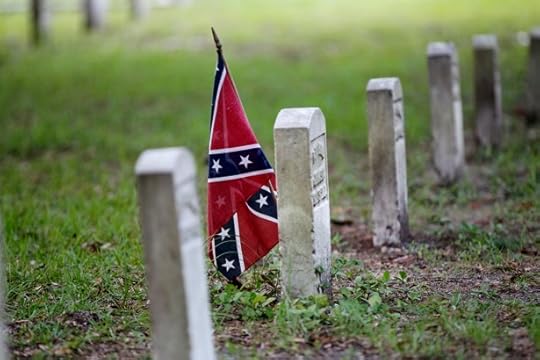
The change in South Carolina politics over the last few days has been nothing short of shocking. The flag of the Army of Northern Virginia seemed firmly ensconced on the grounds of the state capitol in Columbia. Governor Nikki Haley insisted that discussion of the flag’s status was for another day. Senator Lindsey Graham said that while it would be “fine” with him to revisit that decision, it was merely a symbol.
It turns out that symbols matter. On Monday, Haley stood up at a press conference and called for the flag to be removed, insisting that the legislature act immediately. If it didn’t, she would call a special session to address it. She was flanked by Tim Scott, a black Republican senator, and Graham also voiced his support for her move. That followed a call over the weekend for the flag’s removal from Mitt Romney, and the RNC followed Haley’s announcement with an endorsement. Walmart also said Monday that it would quit selling Confederate merchandise.
It isn’t as though the flag only now became a lightning rod, though the massacre of nine black South Carolinians in Charleston clearly shifted the tide. Democratic and even Republican presidential candidates have called for it before—John McCain did so in 2000, though only after losing the state’s primary—and in 2000, state legislators moved the flag from atop the capitol to a site nearby on the grounds. But removing it altogether still seemed too politically difficult in the first state to secede from the union.
Related Story
Even in February 2015, when Public Policy Polling (caveat lector) asked about the flag, half of South Carolinians backed keeping it, with only 40 percent opposed. That despite the fact that nearly half also felt it was bad for the state’s image. (Astonishingly, 35 percent said they thought it was good for the Palmetto State’s reputation.)
It’s still possible that South Carolina legislators could hold a speedy vote and in doing so reject the idea of removing the flag. Given that doing so would require bucking all three statewide elected officials and the national Republican Party, it seems unlikely—though one legislator has already likened Haley’s call to a “Stalinist purge.” (The Charleston Post & Courier is conducting a running whip count here.)
The question for the coming days is this: Is the fury directed at the flag in South Carolina, ignited by the Charleston massacre, contained within the Palmetto State’s borders and subject to local pressure and grief? Or can the righteous anger and arguments directed at that flag work in other states as well?
If it’s the latter, there are many places for it to spread. Elements of either the battle flag or the flag of the Confederate States of America were incorporated into the flags of several other Southern states, most notably Mississippi. Major highways are named for Jefferson Davis and Robert E. Lee. Statues of Lee, Davis, and CSA Vice President Alexander Stephens represent their states in the U.S. Capitol’s Statuary Hall. The database of the National Center for Education Statistics shows at least 20 schools named for Robert E. Lee, and nine apiece for Stonewall Jackson and Jefferson Davis.
In 2011, then-Representative Jesse Jackson Jr. told me about traveling through the South after his election, hoping to better understand American history. He was shocked by what he saw—even as soon as he crossed the border from Washington into Virginia and discovered he was on the Jefferson Davis Highway. “In the South, many states are replete with high schools named after the generals who were some of the great traitors of our country’s history,” he said. “Jefferson Davis has nothing named for him in Washington, and Abraham Lincoln has very little named for him in Virginia.” (Jackson was later convicted of wire and mail fraud and resigned.)
“In the South, many states are replete with high schools named after the generals who were some of the great traitors of our country’s history.”The first, most obvious place for the battle against Confederate symbols to continue would be Mississippi, where the state flag wholly incorporates the battle flag. Evangelical leader Russell Moore, in a widely cited post on Friday, called for its removal from the flag of his native Mississippi. But support for the flag, at least among white conservatives who dominate government, seems to remain high. A state legislator delivered a broadside against Romney for his comments about South Carolina. Governor Phil Bryant cited a 2001 referendum in which two-thirds of Mississippians voted down an attempt to remove the Confederate standard from the state flag. "A vast majority of Mississippians voted to keep the state's flag, and I don't believe the Mississippi Legislature will act to supersede the will of the people on this issue," Bryant said in a statement. Recent polling on the flag is sparse, but a 2014 poll found that if the Civil War broke out today, only 50 percent of Mississippians would side with the Union, while nearly 30 percent would secede.
There are plenty of other targets. On Monday, Representative Jim Cooper called on Tennessee to remove a bust of Confederate General Nathan Bedford Forrest from its state capitol. In Texas, more than 1,700 students signed a petition to remove a statute of Jefferson Davis from the grounds of the University of Texas-Austin.
Also Monday, Baltimore County, Maryland, asked the city of Baltimore to join in rechristening a park named for Robert E. Lee. A Confederate monument in the city was vandalized with graffiti reading “Black Lives Matter.” It’s hard to imagine there won’t be similar cases of both political pushes and vigilante action against Confederate monuments in the next few days—in part because the burgeoning national network of civil-rights activists that has coalesced since Ferguson seems to have taken up the flag cause as its own. DeRay Mckesson, one of the most prominent spokesmen of that movement, tweeted a Vine of a Confederate flag burning, and #TakeItDown rallies inspired by Charleston’s are planned.
It’s an interesting and somewhat surprising turn for the activist movement. Until now, post-Ferguson protests have tended to focus on a single, tangible issue: police violence against people of color. As Johnetta Elzie, another high-profile activist, told Jay Caspian Kang: “Our demand is simple: Stop killing us.” The flag is a far more symbolic issue, if still clearly connected to the question of violence against black Americans. There was a gathering sense of unease already on Monday, a worry that the focus on removing the flag might provide a too-easy exit for leaders in South Carolina to declare victory and move on without grappling with deeper, systemic strains of racism in a state where the black poverty rate is nearly three times as high as the white rate; black incarcerations rates are nearly four times as high; black arrest rates are disproportionately high; and black high-school graduation rates lag white rates.
There are reasons to think that the push to get rid of monuments named for Confederates may sputter. The RNC’s statement on South Carolina notably didn’t mention Mississippi, and Republican presidential candidates’ timid tiptoeing around the flag issue in South Carolina doesn’t seem to portend bold demands from them.
“I don't believe the Mississippi Legislature will act to supersede the will of the people on this issue.”That shouldn’t obscure the fact that there are detectable shifts in attitudes toward the Confederacy and other white-supremacist monuments already, in the last decade and a half. One factor is surely the simple passage of time, as connections to the old Confederacy fade, while changing attitudes about race and shifting demographics in the south are two more. In 2013, a Florida high school’s name was changed so it 







Has Obama's China Strategy Failed?

China and the United States are a bit like squabbling family members: Whatever their differences, they still find a way to get together. These regular gatherings are generally a promising sign for the future of U.S.-Chinese relations, even if the summits themselves often achieve little of substance.
On Tuesday, U.S. Secretary of State John Kerry and Secretary of the Treasury Jacob Lew will carry on this tradition, meeting with their Chinese counterparts Wang Yang and Yang Jiechi in the seventh Strategic and Economic Dialogue in Washington, D.C. The two-day gathering comes shortly after revelations that Chinese hackers pulled off a massive breach of U.S. government files, gaining access to sensitive information including the Social Security numbers of government personnel. The Chinese government claims it didn’t orchestrate the cyberattack, though it has long accused the United States of staging similar attacks on Chinese infrastructure. The official denial has done little to tamp down mutual suspicion in the Sino-American relationship.
Overall, U.S.-China ties are currently stable, a point reiterated by Chinese President Xi Jinping after Kerry’s visit to China in May. But the U.S. government’s long-term strategy on China appears to be adrift. Over the last two decades, America’s China policy has consisted of two major goals: integrating the Communist Party-ruled country into the U.S.-led global economic order, and maintaining American hegemony in the western Pacific Ocean. Both goals now seem to have stalled.
“The consensus of 35 years and five administrations about how to deal with China is fraying severely.”Consider the objective of exerting American influence in the South and East China Seas. China believes it is entitled to a vast swath of the western Pacific. The United States and many other Asian countries disagree. In recent years, Beijing has tussled with its neighbors over the sovereignty of numerous island chains, such as the Spratly and Paracel, in waters that are believed to contain vast fossil-fuel deposits. Last month, a surveillance aircraft flown by the U.S. Navy uncovered purported Chinese dredging vessels operating near the Spratly Islands, an archipelago claimed by China as well as Brunei, Taiwan, Malaysia, Vietnam, and the Philippines. An annual report released by the Pentagon in May revealed that China has begun developing its own islands in disputed waters, constructing over 2,000 acres of land for potential military use.
According to the Financial Times, the Pentagon has prepared options for retaliating against China. But “such proposals are not universally supported within the [Obama] administration” since some officials are “wary of a confrontation” with Beijing. When asked about China’s island policy last week, Daniel Russel, an assistant secretary of state for East Asia and the Pacific, told Reuters that the United States had an “unwavering determination … to avoid military confrontation, including with China.” Such a position might head off a major military confrontation, but it might also fail to compel Beijing to retreat from its maritime claims.
On the economic front, China’s accession to the World Trade Organization in 2001 was considered a major coup in Washington’s attempt to fold Beijing into U.S.-dominated financial institutions. Now China is starting institutions of its own. Last October, China launched the Asian Infrastructure Investment Bank (AIIB), a financial institution akin to the World Bank with a total authorized capital of $100 billion. As the new bank gobbled up prospective members, the United States vigorously tried to dissuade its allies from joining. It didn’t work. While Japan and Canada have thus far refrained from joining, Australia and the United Kingdom deflected U.S. pressure and became prospective founding members earlier this year, embarrassing the Obama administration in the process.
Meanwhile, Barack Obama’s major initiative in the region, the Trans-Pacific Partnership (TPP), recently suffered a significant setback when members of the president’s own party gutted it in the House of Representatives. If passed, the TPP would remove trade barriers between the United States and numerous allies in East Asia, including countries, like Japan and Vietnam, that are embroiled in territorial disputes with China. The Obama administration is trying to work with its recalcitrant allies in Congress to salvage remnants of the TPP, but its failure to push the whole initiative through the legislature stands in contrast with China’s efficient assembly of the AIIB.
In 2011, the Obama administration announced its intention to shift, or “rebalance,” U.S. foreign policy toward Asia, with then-Secretary of State Hillary Clinton proclaiming “America’s Pacific Century.” Now, former U.S. Treasury Secretary Lawrence Summers wrote last week, “The repudiation of the TPP … would leave the grand strategy of rebalancing U.S. foreign policy toward Asia with no meaningful nonmilitary component.” And that military component, as discussed above, isn’t going so well either.
China and the United States do have constructive items on this week’s agenda, including work on a long-overdue bilateral investment treaty and a climate-change deal announced last November during Obama’s visit to China. But the formal meetings obscure a messier reality: Do U.S. officials have a clear and coherent vision for what to do about China? For the past few decades, successive American presidents have argued that by giving its competitor a place in the U.S.-led international order, China would come to act more in concert with American interests. Has that really happened?
“The consensus of 35 years and five administrations about how to deal with China is fraying so severely that we have lost confidence in the fundamental underpinnings of U.S.-China policy,” Frank Jannuzi, a former Asia advisor to John Kerry and the head of the Mansfield Foundation, a Washington-based think tank, told the Financial Times. It’s a challenge that yet another Strategic and Economic Dialogue between the two countries is unlikely to resolve.









The White-Supremacist Group That Inspired a Racist Manifesto
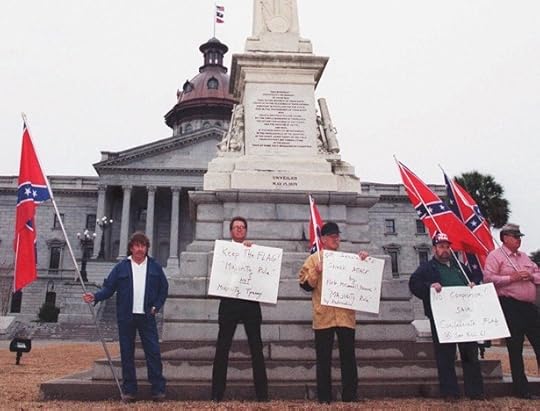
Dylann Roof’s turn to a radical belief in white supremacy was a recent development, according to his friends and acquaintances. But the roots of his belief apparently run much further back, to an organization founded in the 1950s.
In a manifesto uncovered over the weekend, an author widely believed to be Roof wrote that he began Googling after the murder of Trayvon Martin. “The first website I came to was the Council of Conservative Citizens,” he wrote. “There were pages upon pages of these brutal black on White murders. I was in disbelief. At this moment I realized that something was very wrong. How could the news be blowing up the Trayvon Martin case while hundreds of these black on White murders got ignored?”
The manifesto is wrong on the facts. A 2014 report by the Sentencing Project found that the media empirically tend to over-report crimes with black offenders and white victims. But the group he cited, the Council of Conservative Citizens, has spent a great deal of effort trying to convince people that black-on-white crime is a real menace. (Journalists are often bombarded with publicity materials for White Girl Bleed a Lot, a book purporting to reveal the truth about black-on-white crime.)
Related Story
Along the way, the CCC has become the largest white-supremacist group in the nation, according to some observers. Members have donated thousands of dollars to politicians; some national politicians have joined, and dozens have spoken to CCC meetings, often regretting it later. On Monday, Republicans around the country hastened to give back cash they’d received from the CCC’s president, Earl Holt III. Yet despite its size, influence, and unabashed espousal of white separatism, the CCC seems to often go unnoticed, surfacing mostly at times of high racial tension.
The CCC’s roots lie in an older, now-defunct organization called the Citizens Councils of America (also known as White Citizens Council), which aimed to be a (somewhat) more respectable alternative to the Ku Klux Klan for white southerners who opposed integration; the group was sometimes called the “uptown Klan.” In 2010, former Mississippi Governor Haley Barbour, still considered a potential presidential candidate, told Andrew Ferguson, implausibly, that the Councils helped bring about school integration without violence: “The business community wouldn’t stand for it. You heard of the Citizens Councils? Up north they think it was like the KKK. Where I come from it was an organization of town leaders. In Yazoo City they passed a resolution that said anybody who started a chapter of the Klan would get their ass run out of town.”
Barbour’s name soon dropped from consideration. He was right that the Councils helped tamp down the Klan, which seemed uncouth to more buttoned-down segregationists, but once the fight against segregation had been lost, the Councils lost their raison d’etre and slowly faded away. In 1985, according to the Southern Poverty Law Center, which tracks hate groups, a former CCA Midwest field director named Gordon Baum founded the Council of Conservative Citizens as a successor group. Among his co-founders was Lester Maddox, the one-time Georgia governor who rose to prominence after chasing black patrons from his restaurant with an ax handle.
The CCC is now, according to the SPLC, the nation’s largest white nationalist group and at its peak boasted 15,000 members. Though the CCC is sometimes described as “thinly veiled” white supremacists or the like, that’s misleading—it makes little secret of its agenda. (Nonetheless, Ann Coulter has previously stepped forward to defend the group from the white-supremacy attack.) In a statement of principles, the group says:
We believe that the United States derives from and is an integral part of European civilization and the European people .... We also oppose all efforts to mix the races of mankind, to promote non-white races over the European-American people through so-called “affirmative action” and similar measures, to destroy or denigrate the European-American heritage, including the heritage of the Southern people, and to force the integration of the races.
New members also receive a pamphlet about Martin Luther King Day co-written by the late racist Senator Jesse Helms. The Anti-Defamation League collects other examples of ties to hate groups and extremists.
The group also maintains ties overseas; in 1998, according to the white supremacist site American Renaissance, a delegation from the group “had the pleasure of presenting Jean-Marie Le Pen with a Confederate flag that had flown over the South Carolina state capitol.” Le Pen founded France’s far-right National Front, but was recently suspended from the party by its current leader—his daughter—for remarks casting doubt on the Holocaust.
The CCC also prominently protested in 2000 when South Carolina lawmakers moved the Confederate battle flag from atop the statehouse—where it had flown since 1961—to a site elsewhere on the capitol grounds in Columbia.
Since the shooting, and since the manifesto attributed to Roof was revealed, the CCC has moved to distance itself from him. A post on the group’s website condemns the massacre but takes great pains to look for other explanations than racism: Roof’s “interest in racial politics started only very recently,” it says, suggesting that drugs could have been a factor and noting that some of Roof’s apparent Facebook friends are black. It also implies that his friends are to blame for not stopping him. In a separate post, the CCC again condemns Roof but insists that the danger of black-on-white crime is real. The statement directs inquiries to Jared Taylor, who also runs American Renaissance.
In 1998, a delegation from the group “had the pleasure of presenting Jean-Marie Le Pen with a Confederate flag that had flown over the South Carolina state capitol.”Despite its open espousal of white supremacy—or, a cynic might say, because of it—the group continues to attract high-profile politicians. Then-Representative Bob Barr of Georgia, a Republican (and later a Libertarian presidential candidate), delivered a keynote address to the group in 1998. Senator Trent Lott of Mississippi, who was forced to resign the Senator Majority Leadership after praising Senator Strom Thurmond’s segregationist “Dixiecrat” presidential bid of 1948 at a 100th birthday party for Thurmond, was also linked to the group. “Sen. Trent Lott once addressed this group's national board, welcomed its leaders to Washington, had photos taken with them in his office and then said he didn't know what they were about,” The Washington Post reported. “The CCC's directors wink and nod at that. One of them was a county chairman of Lott's '94 reelection campaign. One of them is his uncle.” Mike Huckabee also delivered a speech to the CCC, via video, in the early 1990s, but later condemned the group.
Why do politicians keep speaking to the CCC? The outwardly neutral name might have something to do with it. Every time a politician is caught, he—like Lott—insists he didn’t know what the group’s stances were. When it was revealed that Representative Steve Scalise had spoken to a different racist group earlier in his career, he too said he didn’t know about its position—and at least one black Democratic colleague vouched for him.
The fact is that politicians are eager to raise money and often don’t carefully vet groups before speaking to them. And CCC members have spread their money around. As The Guardian first reported over the weekend, CCC President Earl Holt III has donated some $65,000 to candidates in recent years, including GOP presidential hopefuls Ted Cruz, Rand Paul, and Rick Santorum. (Holt took over the group after Baum’s death in spring 2015.) Holt’s contribution records read as a who’s who of conservative candidates in recent years—including Mark Sanford, who represents Charleston in the House. Holt has given to black candidates, including Representative Mia Love of Utah and former Representative Allen West of Florida. Bizarrely, in some of his donations, Holt identifies himself as a self-employed “slumlord”; others call him a real-estate developer or landlord. Commenter accounts around the web using his full name are repositories of racism and slurs.
On Monday, many of the politicians who received donations hastened to give the money back. The “toxic donor” story is a familiar one in politics—group or individual does bad thing; reporters find contributions; recipients give back money; news cycle returns to normal. The CCC has survived multiple turns in the media spotlight, and as revolting as its ideology is, it’s perhaps not surprising that it can continue to find adherents. The question is whether politicians will be wise enough not to affiliate themselves with it once again.









The President’s Candid Garage Interview
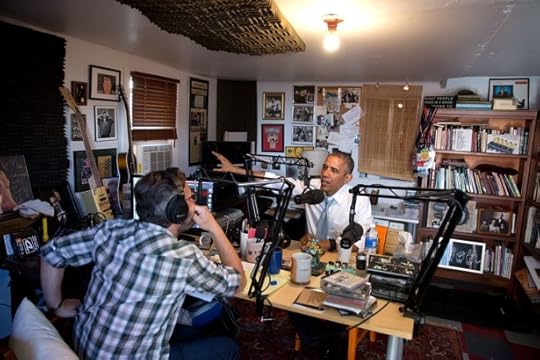
Marc Maron has long excelled at putting his interview subjects at ease. His podcast WTF with Marc Maron sees the comedian chat with guests in the garage of his East L.A. home, often drawing out candid opinions or previously untold personal truths. The informality of the setting, and Maron’s own propensity to overshare, both work to his advantage.
Related Story
Why There's No Conservative Jon Stewart
The show typically features other comedians, so when President Obama dropped by, he made for an atypical guest (Maron talked about the intense security measures that come with a visit from POTUS, down to the snipers perched on the garage roof.) But unconventional interviews seem to be the president’s favorite kind—he’s spent time with Zach Galifianakis on the satirical web series Between Two Ferns, and even switched roles when he grilled David Simon about The Wire and incarceration rates at the White House earlier this year. Obama’s interview with Maron retained WTF’s characteristic informality, allowing the President to bring a little more candor to topics he’s wrangled with since taking office.
The most widely highlighted aspect of the interview was the President’s blunt language in talking about the country’s legacy of racism and its sometimes-superficial standards of progress. “We’re not cured of it. And it’s not just a matter of not being polite to say ‘n****r’ in public. That’s not the measure of whether racism still exists or not. It’s not just a matter of overt discrimination. Societies don’t overnight completely erase everything that happened 200 or 300 years prior,” he said. It was quickly noted as his first public use of the racial slur, prompting rapid pundit debates that perhaps underlined his point: that the primary manifestation of racism isn't merely impolite public discourse, as America wrestles with the profound tragedy in Charleston.
Obama’s remarks didn’t come off as pithy, nor as some shocking move intended to prove a point, but rather felt like a byproduct of Maron’s relaxed interview environment. The setting gave the president a chance to ruminate without having to respect the familiar boundary of the day’s talking points. “I always tell young people, in particular, do not say that nothing has changed when it comes to race in America, unless you've lived through being a black man in the 1950s or ‘60s or ‘70s,” Obama said. “It is incontrovertible that race relations have improved significantly during my lifetime and yours.”
While focusing on a single word might miss the forest for the trees, Obama’s frankness was still notable, particularly two days after the attack in Charleston. It’s easy to imagine that, earlier in his presidency, Obama might have canceled a seemingly frivolous interview appearance during a sensitive moment for the nation. But his appearance on WTF underlined his foray into more offbeat media spheres as his presidency winds down, and he acknowledged his shift in mindset as his talk with Maron came to a close. Having served one-and-a-half of his two terms in office, Obama said, “I know what I’m doing, and I’m fearless. You’re not pretending to be fearless … that’s such a liberating feeling.”
Obama’s appearance underlined his foray into offbeat media spheres as his presidency winds down.Rather than just repeatedly touring the studios of Meet the Press and This Week, the President has slow-jammed the news on The Tonight Show, showed up on Bill Simmons’ sports-centric B.S. Report and plugged Obamacare on Between Two Ferns, seemingly trying to reach a wider and younger audience. Critics might complain about the softball approach that comes with a less politically seasoned interviewer, but that didn’t stop Galifianakis from asking him, “What’s it like to be the last black president?”
Nor did it stop Maron from probing interesting personal matters with his guest, even if the interviewer steered away from some of his usual favorite topics (caring for his four cats, perhaps, or his opinion on Saturday Night Live producer Lorne Michaels). Talking about his relationship with his wife, the President recalled that his propensity for lateness was an early point of conflict in their relationship, before he realized the deep-seated reasons why Michelle was so irked with him. She grew up with a father who had multiple sclerosis, he recalled, and who had to wake up an hour earlier just because the task of dressing for work was so laborious for him. “That mentality of not wanting to stand out, and not wanting to miss something, instilled in her a very emotional thing.”
Maron did get to ask his most common query, perhaps his simplest: “How are you crazy?” Also, “Tell me your most deep-seated insecurities or quirks.” It came in the middle of a conversation about Obama’s growing up without a father, and the president’s answer was one millions of Americans could no doubt relate to: that he wanted to make sure his children had the opposite experience, akin to the Leave it to Beaver lifestyle Michelle grew up in, he said. None of this is breaking news—Obama wrote about his relationship with his absent parent years before his election in his memoir Dreams from My Father—but it was delivered plainly and relatably, one guy chatting to another in a garage—the gift of a format most political interviews could never replicate.









Taylor Swift Almighty

Very soon after Apple signaled it would reverse course in business negotiations because of something Taylor Swift wrote on the Internet, BuzzFeed published a list of 18 other issues Swift could fix by blogging about them. Spiders, people who walk too slow, Piers Morgan—what problems couldn’t the singer solve? Meanwhile the same sentiment, awe at Taylor Almighty, was being shared across the Internet. Elvis Costello tweeted that she was “our future president.” Industry observer Bob Lefsetz called Swift “the most powerful person in music.”
Related Story
Swift had intervened in a struggle brewing for weeks between Apple and the independent music labels, publishers, and artists it was negotiating with to license songs for the company’s forthcoming on-demand streaming service, Apple Music. The sticking point: To lure customers to sign up upon launch, Apple would offer a free three-month trial period, during which, it proposed, it would not pay artists when their songs were streamed. Swift took to Tumblr on Saturday to explain she would withhold her most recent album, 1989, because Apple’s terms were “shocking, disappointing, and completely unlike this historically progressive and generous company.”
A day later, Apple VP Eddy Cue announced Apple would pay royalties during the free trial period. “We hear you @taylorswift13 and indie artists,” he tweeted. “Love, Apple.”
Is it really true that Swift made the most valuable company in the world switch its policy overnight? Cue told The New York Times that Swift’s note “solidified that we need to make a change,” which implies that he’d been considering it already. The service is set to go live on June 30, and as of now, Apple has nailed down agreements with the major labels but not the big independents. Recently, some of those independents publicly criticized the three-month trial terms and other aspects of the deal Apple had offered. A proposed solution, in which Apple would pay a slightly higher royalty rate in the long run in exchange for the free period, still presented problems: Albums released during the trial window would potentially make almost no money from the service, and other revenue streams could be hurt as consumers try out the new product. Could Apple Music have credibly launched for consumers without offering a huge portion of the independent catalog—including, for example, all of Adele’s recordings? Observers were skeptical.
So, Apple might have come to this point even without Swift’s note. Unless more info about the state of negotiations and Apple’s internal calculations leak, it’s impossible to know. Last year, Swift similarly called out Spotify for its “freemium” model and pulled her albums from the service, but that company hasn’t changed course. The business calculation for Apple is different, though. It’s launching something new and, with all its iPhone money in the bank, can theoretically afford the costs of three months of royalties; Spotify’s popularity has largely been predicated on free offerings, and it has yet to turn a profit.
Apple’s brand is in large part about being a friend of the creative community, and it takes a hit when someone of Swift’s status calls it out.What seems certain is that the free-trial discussion, like most ones regarding rights and record labels in the 21st century, would have gone on without much public notice if Swift hadn’t spoken up. Apple, whose brand is in large part about being culturally cool and a friend of the creative community, takes a very real hit when someone of Swift’s status calls it out. She has the fourth-most Twitter followers of anyone in the world, and her “Swifties” are more fervent than many others. This is a woman who invites fans into her home, writes them handwritten notes, and pays for their student loans.
Often, people deride such fan service as being self-congratulatory PR work. But the truth is that all Swift’s efforts to tend to her following—though music, through promotion, and yes, through baking cookies—amount to real-world leverage. Universal, the label she’s on, streams all its music on Spotify, and yet—likely because her record contract features special terms that reflect her immense popularity—she was allowed to divest from the service. Beggars, the independent record company whose roster include Adele, spoke out against Apple Music’s free trial days ago and had nowhere nearly the public splash Swift had. This doesn’t necessarily make her the most powerful person in music—she can’t commit thousands of artists to a deal like, say, Lucian Grainge, the head of Universal Music, can. But it does give her independence and influence.
Other artists have similar followings, but use them less effectively. Jay Z, Beyoncé, Madonna, Kanye West, Jack White, and the others artists involved with the streaming service Tidal have tried to create a competitor to Spotify and Apple Music whose appeal is largely based on the fact that they’re the ones running it. The response has been tepid at best. Those artists, in essence, turned to the fans they’ve earned over the years and asked for money. When it came to Apple, though, Swift demanded nothing of the people who love her. She just pointed out something that she wished would change, and it did.









The Return of Janet Jackson

In April, a “missing person” poster began circulating around the Internet. The person’s date of birth? May 16, 1966. The person’s height? A little north of 5 feet. The location of the person’s last known whereabouts? Milan, Italy. The person in question? Janet Jackson.
“Seriously Janet, where the hell are you?” the joke-poster asked the superstar. “We NEED you back. We miss you. Your fans miss you. THE MUSIC INDUSTRY NEEDS YOU. Come back and show these young whippersnappers how it’s done!”
Related Story
This was a cheeky way of acknowledging something that had been the source of both sadness and frustration for Jackson’s fans for several years: The pop star—one of the few people in the industry who can unironically be called a “megastar”—had, of late, pretty much disappeared from the public eye. Her last album, Discipline, was released in 2008. Her appearances on awards shows had dwindled after the one she made at the BET Awards in 2009, where she tearfully paid tribute to her brother Michael just three days after his death. In 2012, Jackson married the Qatari billionaire Wissam Al Mana—and has, per reports, been spending the bulk of her time in the Middle East. Away from Hollywood, away from the music industry, away from her fans.
All of which makes today a great day for the #janfam: Janet Jackson, it seems, is making a comeback. Another comeback. On Monday, Jackson released a new single, “No Sleeep,” on YouTube. The slow-jammed, sultry tribute to the various ironies of the phrase “sleeping together” is the lead track from her new album, Unbreakable, set for release in the fall of 2015. Per a press release, the song
is a collaboration between Janet Jackson and the legendary songwriting and production duo Jimmy Jam & Terry Lewis, with whom Ms. Jackson first teamed up with in 1986. Jimmy Jam and Terry Lewis have collaborated with Ms. Jackson on a number of her biggest hits, including a staggering nine Billboard Hot 100 number ones.
The song is also, however, a sign that Jackson is, indeed, no longer “missing”—and not just because of the oh-so-Internet-y extra “e” in “sleeep.” Her reappearance had been teased for a while, via occasional tweets from Jackson’s account and, last week, a video from the singer; now, though, the comeback is official. And: big! On Sunday, Jackson will appear at the BET Awards, where several artists (including, it’s rumored, Ciara) will perform in a tribute to her. And then, when she releases Umbreakable, Jackson will do what you do when you’re a pop superstar with a new album: Take it on the road. The Unbreakable tour, starting in late August in Vancouver, will see Jackson playing 36 dates in 32 cities worldwide.
It will see Jackson, in other words, insisting that she still has something to say, something to contribute—and something beyond the stuff of simple nostalgia. Mixed among the sultry notes of “No Sleeep” are tones of defiance: Being away, the song insists, is not the same as being gone.
Those are significant messages from an artist whose relationship with the music industry as a whole has been, at times, fraught. The 1993 album Janet.—the missing surname pointedly replaced by a period—was interpreted by many as Jackson’s statement of artistic independence to an industry that had insisted on grouping her with her famous family. In a similar way, some blamed the “relative flops” of the singles on Jackson’s last original album, 2008’s Discipline, on the fact that many radio stations, after Jackson’s “wardrobe malfunction” at the 2004 Super Bowl, refused to play her music. Billboard was punishing Jackson, the thinking went, for the obscenity that was baring a breast on live TV.
You could read “No Sleeep,” which is so unapologetically sultry and so explicitly about sex, as another instance of Jacksonian defiance: as evidence of the artist deciding for herself what her music is, and is not, going to be. You could also see it as evidence of the social changes that have taken place since Jackson was last in the limelight: An almost-exposed nipple today doesn’t seem like much of a scandal. But the song is also evidence of a simpler idea: that being down isn’t the same as being out. As Jackson put it in a tweet this spring, just as she began to come out of her temporary reclusiveness: “Letting go doesn’t mean you stop.”









Was the Charleston Attack 'Terrorism'?

Dylann Storm Roof, the 21-year-old who allegedly murdered 9 people at a black church in South Carolina, wanted to “start a race war,” one of his friends told ABC News. His Facebook profile showed him in a jacket “adorned with two flags––one from apartheid-era South Africa, the other from white-ruled Rhodesia––that have been adopted as emblems by modern-day white supremacists,” the New York Times reported. A witness says he spared the life of a woman inside the Emanuel A.M.E. Church so that she could relay what happened to the public. And his stomach-churning manifesto leaves no doubt as to his white-supremacist motives.
There is a word for premeditated violence against civilians by non-state actors who intend to stoke fear, anger, and social strife in service of their extremist ideology.
That word is terrorism.
Last week, a historic black church in South Carolina suffered a deadly terrorist attack. And media outlets were correct to hold off on applying that fraught label prior to confirming that the facts about the mass killing matched the earliest reports.
In recent U.S. history, terrorism has been invoked, manipulated and exploited to justify torture, the Iraq War debacle, a drone war that has killed countless innocents, an unprecedented program of mass surveillance on totally innocent people, and numerous abrogations of civil liberties, especially against Muslims. So there is good reason to insist on invoking the concept carefully and rigorously, when fixed definitions are met, rather than reflexively or to confer rhetorical heft. Murdering first graders is a heinous crime; but I do not call the massacre at Sandy Hook elementary a terrorist attack, as there is no evidence that Adam Lanza, the perpetrator, acted to stoke terror and advance a political agenda.
Since 9/11, many journalists have been less than rigorous with their application of the terrorism label; and many right-wing media critics are apoplectic, in the immediate aftermath of violence perpetrated by apparent Muslims, when careful journalists wait for evidence of motive rather than reflexively calling an attack “terrorism.” Insufficiently rigorous journalists error in the opposite direction too, failing to apply the terrorist label to violence that clearly meets any reasonable definition, sometimes due to political correctness and other times because the terrorism was perpetrated by a white person or a Christian or an Israeli. Today, “terrorism is typically associated with Muslim extremism,” Dara Lind writes. “When white people commit mass shootings, their ideology isn't as often brought to the fore. But because of the history of terrorism in the South, for many, labeling the Charleston church shooting terrorism is a way to recognize that black lives matter.”
By demanding that the Charleston church attack be dubbed terrorism even before key details were known, observers meant to assert some mix of other claims, including that even the earliest details of the attack very strongly suggested that it was rooted in racial hatred against blacks and white-supremacism; that the killer acted every bit as abhorrently as, say, the men who attacked the Boston marathon; that the black lives lost to this and other acts of white supremacist terrorism matter every bit as much as the lives lost on, say, September 11, 2001; that the press, the police, and politicians would’ve responded differently to this attack had it been perpetrated by a Muslim gunman; or that Charleston warrants a response in keeping with what follows attacks by Muslim terrorists.
I find the first four of these claims more compelling than the last.
As for how to respond to the Charleston attack, that is a bit more complicated. As noted, I call it a terrorist attack because it meets the accepted definition. And insofar as the mass murder and hate crime deserves the maximum opprobrium that a society can muster; insofar as the lives lost matter every bit as much as those of any murder victims ever have; and insofar as a radical, poisonous ideology is partly responsible for the killing, I endorse treating it “like a terrorist attack.”
But there is another sense in which it is vital that we do not treat Charleston “like a terrorist attack.” In America, the label terrorism often adds more heat than light; helps demagogues to manipulate the public; helps frighten people far beyond what is justified by the actual threat that members of the target group faces; clouds the judgment and moral compass of politicians, bureaucrats, police, prosecutors, and judges; and leads directly to the state needlessly victimizing innocent people.What a shame that a label increasingly seen as a proxy for caring can produce such a callous response!
The label can also makes it harder to squarely face the facts of what happened, a crucial prerequisite for taking the smartest possible steps to preventing recurrences.
“The collective denial of ongoing racism allows us... to classify the deaths of nine people killed in church as the alleged victims of a mentally ill individual rather than a racist terrorist,” Steven W. Thrasher wrote in The Guardian. He is correct that some reactions to the Charleston murders exemplify idiotic denials of ongoing racism. But the proper position to take on the mental health or illness of the perpetrator is agnosticism, pending the emergence of further evidence. Mental illness does not render one unable to perpetrate a terrorist attack, and its presence or absence should be treated as a discoverable fact, not a proxy for racial enlightenment or how seriously the attack is taken. This is not to ignore or dismiss the wrongheaded reflex of some media outlets to label all violent Muslims “terrorists” and all violent white men “mental cases.” It is to call for rigor in all cases.
For those persuaded that the Charleston attack was terrorism, but who also want to avoid pitfalls associated with that label, what should happen going forward? Without pretending to have a comprehensive answer, I’d suggest that after any terrorist attack, observers should work to deny terrorists one of their core aims: to terrorize people far out of proportion to the threat that their actions actually pose. In Charleston, the killer was successfully apprehended without shutting down a city, and the criminal justice system will prove perfectly capable of trying, convicting, and punishing him.
How best to fight his ideology is a thornier but no-less-necessary concern.
The attacker was an outlier even among self-avowed white supremacists, and no set of beliefs is more stigmatized in U.S. society than those he held. At the same time, he was radicalized by hate-group propaganda as surely as Tamerlan Tsarnaev, and is hardly the only radicalized white supremacist to carry out a devastating attack.
Years ago, after an attack on a Sikh temple that’s mostly forgotten because it wasn't regarded as terrorism, I argued that the reluctance to apply the label to acts carried out by white people is partly due to an awareness of what might happen next. When terrorism is invoked, many Americans––Republicans especially––have assented to indefinite detention; the criminalization of gifts to certain charities; secret, extrajudicial assassinations; ethnicity-based surveillance; and the torture even of people who might know about a future attack. Having undermined so many civil-liberties protections in pursuit of terrorists, the white majority and Republicans especially are alarmed at the idea of the homeland-security bureaucracy treating them as they’ve treated Muslim Americans.
The ideal solution would be rational efforts to combat terrorists of all kinds that are transparent, unlikely to create more radicals, and consistent with the Bill of Rights. America’s approach to counterterrorism presently falls short of those standards, confronting us with this reality: We cannot ignore fringe non-state actors who are determined, for various reasons, to murder innocents in service of evil ends; yet our response to terrorists often causes more harm than they could alone.
Historically, black churches have excelled as surely as any American institution at enduring and triumphing over terrorism without inflicting harm upon others. So while the radical love expressed by members of the Charleston congregation in the face of last week’s hate killings is heroic and awe-inspiring, it is not entirely surprising. As America grapples with how to avert a future terrorist attack of this sort, I suspect it can learn more from its black-church leaders than its political leaders.
May we have the wisdom to listen.









Where Republicans Went Wrong in Kansas
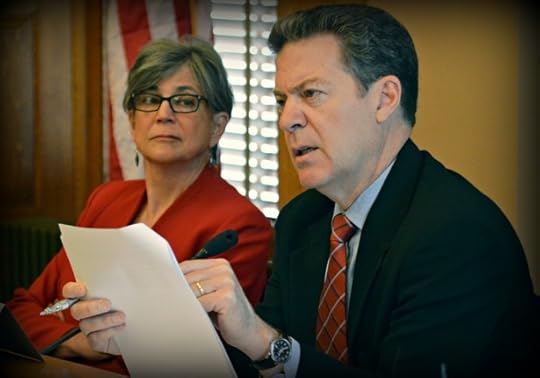
Last Tuesday in Topeka, Governor Sam Brownback of Kansas signed a $15 billion state budget that squeaked through the Republican-dominated Legislature after an unprecedented, 113-day session—more than three weeks longer than the 90 days called for under state law. The governor simultaneously signed a pair of bills that raised $384 million in revenue by hiking the state’s sales tax and a host of other levies, including on cigarettes.
“I don’t know that anybody’s happy about it,” Brownback said.
Talk about an understatement. According to various reports from the state capital, several lawmakers cast their votes in tears, one Republican accused the governor’s administration of blackmail, and exactly no one thought the plan actually solved the state’s longterm budget woes. “Next year will be my 40th year in the Legislature, and I have never seen a session like this one,” Anthony Hensley, who leads the Senate’s small contingent of Democrats, told me by phone on Friday. “It was completely chaotic and dysfunctional.”
Related Story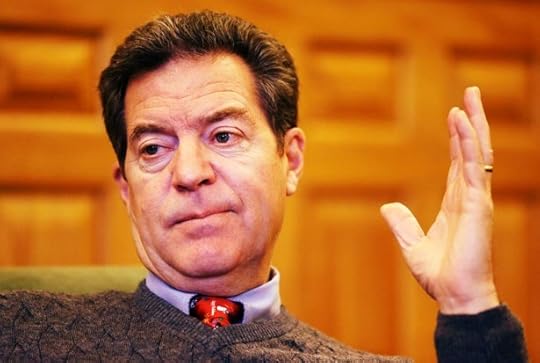
All that new revenue, along with about $50 million in spending cuts, was needed to close a deep deficit that had embarrassed its conservative governor and thrown its legislature into a months-long gridlock that resembled, well, Congress. As we wrote in April, the deficit resulted in large part from Brownback’s own “real live experiment” in supply-side economics—sharp cuts in income tax rates and a huge exemption for owners of small businesses.
Ask any fiscal expert, and Kansas’s budget crisis demanded a reckoning—either with its tax code or its longterm spending structure. But its government wasn’t up to it. Aligned with conservatives in the Senate, Brownback steadfastly refused to consider a direct reversal of the original tax plan, insisting that the state continue on its path toward replacing the income tax entirely with consumption taxes. The most he would do was freeze the rates, and the result was a plan that will place an even heavier tax burden on the poor, according to the Institute on Taxation and Economic Policy. Hensley said that when state and local sales taxes are combined, Kansas will have the highest tax on food in the nation in some areas of the state. Brownback, who had hired the economist Arthur Laffer to help craft his original tax plan, had been touting the state’s economic recovery to argue that his fiscal vision was starting to work. But a report released Friday found that Kansas had lost nearly 4,000 jobs in May, trailing both the national trend and neighboring Missouri, which added 6,600 jobs.
“The governor needs to learn, and I think a lot of the people in the legislature needs to learn, when you cut taxes in the manner that they have, you need to also cut spending.”Lori McMillan, a tax expert and law professor at Washburn University, told me during the middle of the impasse that Kansas lawmakers seemed “paralyzed” by the crisis and the many unpalatable choices they faced. By the time it was finally over, Brownback appeared—at least to his many critics—to be in denial. As described by the Wichita Eagle, the governor refused to acknowledge that he had signed a tax increase. “Look at the totality of the picture,” he said, referring to the far deeper tax cuts he had signed in previous years. “When you look at that, it is a tax cut.”
Nobody else saw it that way. “Not only is this a tax increase, it is the largest tax increase in state history,” Hensley responded in a statement. When I called up Will Upton, the state-affairs manager for Grover Norquist’s Americans for Tax Reform, he described the budget that Brownback signed in almost exactly the same words. Norquist serves as something of an arbiter of tax increases among conservatives, and he’s famously said his goal is to shrink government to a size where you can “drown it in a bathtub.” The problem in Kansas, Upton said, is that while Brownback had succeeded in shrinking the tax burden, he did little to shrink spending.
When the tax cuts were first enacted, Upton said, Democrats and moderate Republicans succeeded in removing provisions that would have softened the fiscal blow. And when Republicans tried to close the budget gap this year, Brownback blamed Medicaid, education, and the state’s pension system as the drivers of the deficit, but there was little effort made to address them. “No one’s really looked at long-term reform yet. They throw up their hands and say, ‘We tried.’ No, they didn’t really try,” Upton said. “The governor needs to learn, and I think a lot of the people in the legislature needs to learn, when you cut taxes in the manner that they have, you need to also cut spending.”
That, of course, is easier said than done. As politically unpopular as any kind of tax increase is, cutting money from healthcare, schools, or retirement funds would spark an even bigger backlash. In that respect, the outcome in Kansas recalls the complaints of conservatives during the George W. Bush administration, when taxes went down but the government—and the deficit—grew. Modest tax increases, spending restraint, and economic growth have helped cut down the gap, but it is far from closed. Kansas may be facing a similar future. Brownback “has sold the Legislature a bill of goods,” Hensley lamented. “Consequently,” he added, “we are going to have a budget shortfall for years to come.”









Atlantic Monthly Contributors's Blog
- Atlantic Monthly Contributors's profile
- 1 follower



